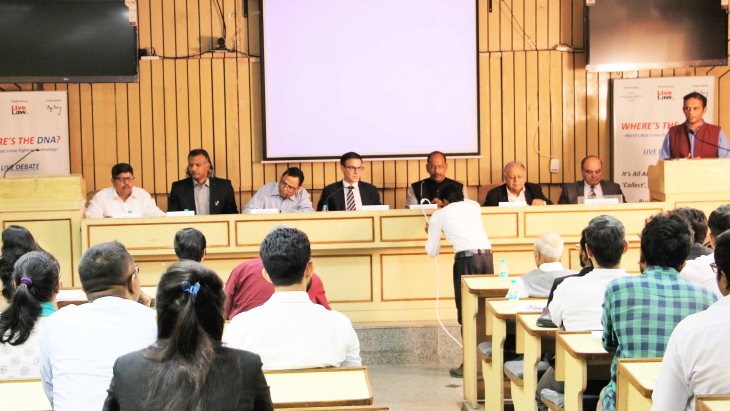 A more aggressive DNA approach at crime scene, in the lab and in the court, will increase conviction rates and make India safer for women
A more aggressive DNA approach at crime scene, in the lab and in the court, will increase conviction rates and make India safer for women
New Delhi, Delhi, India
Crime in India is seen to be on an upsurge, especially rape and sexual assault cases where the conviction rate has fallen from 49% to as low as 29% in the last 3 years (between 2012 and 2015) in Delhi alone, and over 1,37,458 rape cases still stand pending for trial across India[1]. The lack of scientific methods in investigations is hampering justice delivery and the need for DNA casework expansion in India is now increasingly critical and urgent to build conviction in such cases.
“India is simply not collecting enough DNA at violent and sexual crime scenes,” said Tim Schellberg, President, Gordon Thomas Honeywell Governmental Affairs (GTH-GA), a legal and policy expert of forensic DNA. “DNA is the world’s greatest crime fighting tool. Consequently, DNA should be aggressively collected, tested and compared to the accused. DNA testing is happening in India, but not nearly enough,” added Schellberg.
GTH-GA estimates that the United Kingdom completes DNA testing on over 60,000 crime scenes annually. India is over 13 times larger in population that the United Kingdom, yet GTH-GA estimates that India’s crime labs collectively complete DNA testing on less than 7,500 cases annually. This is a very low number.
Furthermore, when DNA is collected, it often goes into large backlogs due to India’s lack of DNA testing infrastructure. The pendency of the backlogs for sample testing in the FSL at Rohini is 5661 and for the one at Chanakyapuri are 458[2. GTH estimates that most of the backlog cases mentioned is likely DNA.
As per the statistics available on the website of Directorate of Forensic Science, Himachal Pradesh[3], the pendency of DNA cases has gone up. In January 2017, the pendency of cases was 605 and in June 2017 was 674, whereas, the average collection of DNA cases is around 30 per month and average disposal of 15 cases a month. This shows almost 50 per cent increase in pendency at FSL per month.
As per the NCRB data, more than 34,651 rapes were registered in 2015. On the contrary, the annual report of the Centre for DNA Fingerprinting and Diagnostics (CDFD)[4] available for the latest year 2015-16 shows that they have received 99 DNA cases specifically for rape from different states.

Senior Advocate, Delhi High Court, Vivek Sood agrees that not enough DNA is being utilized in rape cases. “In Delhi, the numbers of rape cases have tripled over the last five years, registering an increase of 277% from 572 in 2011 to 2,155 in 2016. In these cases, I rarely see DNA evidence presented by the prosecutors during trial. This is because DNA is not properly collected at crime scenes on a routine basis, and when it is collected, it is stuck in long backlogs in our underfunded crime laboratories. As a result, there is an over reliance on verbal statements provided by witness/witnesses in the court that can result in wrongly convicting the innocent. We must have more DNA testing to ensure a swift and just result for both the victims and the accused.”
Collection, transportation and storage of DNA forensic evidence are the key factors in rape investigations, which unless well-preserved and transported to FSL result in weak prosecutions and low conviction rate. India currently has approximately 30 FSLs with varied capacity to examine DNA Samples. To strengthen the criminal justice system, it is therefore critical to invest in the much required infrastructure and upgrading the FSLs for DNA – Collect, Test and Compare.
The availability of DNA when at trial to link the accused to the crime is seen throughout the world as the best way to increase charging and conviction of criminal offenders. One study from Denver, Colorado (United States) shows that when DNA is available the prosecutions, ‘charging rate’ was 8 times higher than cases that did not have DNA casework that matched a known suspect. While this data shows prosecution ‘charging’ and not conviction, the point is made showing how the system likes it when DNA is present. A charge rate that is 8 times higher when DNA is present is a big number and obviously will lead to a higher conviction!
 India can be a far safer place for women if DNA was collected and tested at all violent and sex crime scenes where the criminal offender leaves DNA. This is a must for all law enforcement authorities, and courts and prosecutors to ensure that the DNA be tested quickly and be used in courts to expedite the judicial process.
India can be a far safer place for women if DNA was collected and tested at all violent and sex crime scenes where the criminal offender leaves DNA. This is a must for all law enforcement authorities, and courts and prosecutors to ensure that the DNA be tested quickly and be used in courts to expedite the judicial process.
Gordon Thomas Honeywell Governmental Affairs is globally recognised public affairs consultancy firm that has expertise with forensic DNA database policy, legislative, and law. For nearly twenty years, consultants at GTH-GA have consulted in over 50 countries and states on legislation and policies to establish or expand criminal offender DNA databases. GTH-GA collaborates closely with governmental officials, crime labs, police and the DNA industry. GTH-GA operates the DNAResource.com website that has been used as the world’s primary source for DNA database policy and legislative information since 2000.